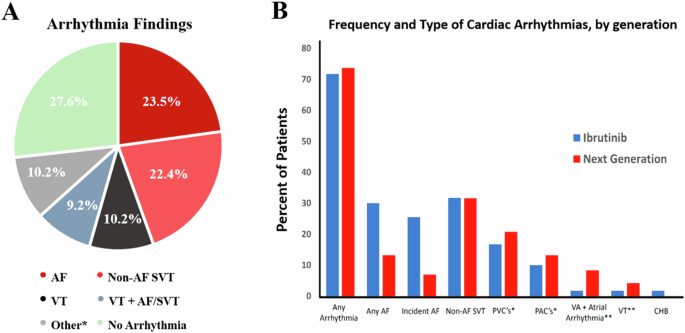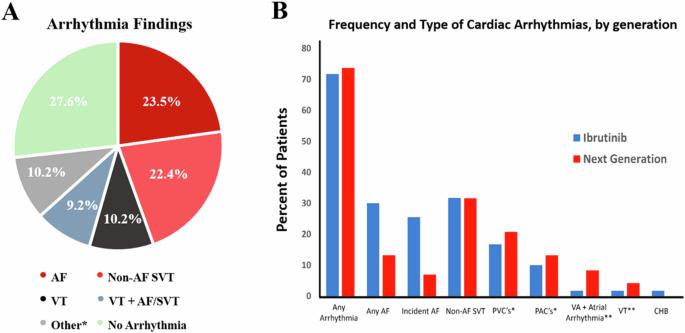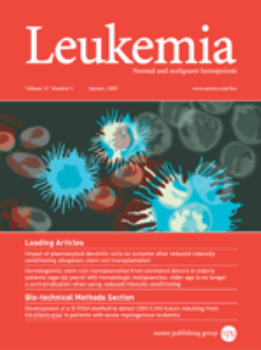Atrial fibrillation burden and clinical outcomes following BTK inhibitor initiation
IF 13.4
1区 医学
Q1 HEMATOLOGY
引用次数: 0
Abstract
Bruton’s tyrosine kinase inhibitors (BTKi) have dramatic efficacy against B-cell malignancies, but link with cardiotoxicity, including atrial fibrillation (AF). Burden, severity, and implications of BTKi-related AF are unknown. Leveraging a large-cohort of consecutive B-cell malignancy patients initiated on BTKi from 2009–2020, we identified patients with extended ambulatory rhythm monitoring. The primary outcome was AF burden after BTKi-initiation. Secondary outcomes included ventricular arrhythmia burden and other arrhythmias. Observed incident-AF rates and burden with next-generation BTKi’s were compared to ibrutinib. Multivariable regression defined association between rhythm measures and major adverse cardiac events (MACE), and mortality. There were 98 BTKi-treated patients [38.8% next-generation BTKi’s, 14.3% prior-AF], with 28,224 h of monitoring. Median duration BTKi-use was 34 months. Over mean duration 12 days monitoring, 72.4% developed arrhythmias (16.3% incident-AF, 31.6% other SVTs, 14.3% ventricular tachycardia). 14.3% had high AF-burden. AF-burden was similar between ibrutinib and next-generation BTKi’s. No single antiarrhythmic-therapy prevented BTKi-related AF. However, antiarrhythmic initiation associated with reduction in arrhythmic burden (P = 0.009). In a multivariable model accounting for traditional cardiovascular risk factors, prior-AF associated with increased post-BTKi AF-burden. In follow-up, high AF burden associated with MACE (HR 3.12, P = 0.005) and mortality (HR 2.97, P = 0.007). Among BTKi-treated patients, high AF burden prognosticates future MACE and mortality risk.


开始使用 BTK 抑制剂后的心房颤动负担和临床结果。
布鲁顿酪氨酸激酶抑制剂(BTKi)对 B 细胞恶性肿瘤有显著疗效,但与心脏毒性有关,包括心房颤动(AF)。BTKi相关房颤的负担、严重程度和影响尚不清楚。我们利用 2009-2020 年间连续接受 BTKi 治疗的 B 细胞恶性肿瘤患者的大型队列,确定了长期接受非卧床心律监测的患者。主要结果是开始使用 BTKi 后的房颤负荷。次要结果包括室性心律失常负荷和其他心律失常。观察到的新一代 BTKi 与伊布替尼的房颤发生率和负担进行了比较。多变量回归确定了心律测量与主要心脏不良事件(MACE)和死亡率之间的关联。共有98名BTKi治疗患者[38.8%为新一代BTKi,14.3%为既往AF],接受了28224小时的监测。使用 BTKi 的中位时间为 34 个月。在平均为期 12 天的监测中,72.4% 的患者出现了心律失常(16.3% 为偶发性房颤,31.6% 为其他 SVT,14.3% 为室性心动过速)。14.3%的患者房颤负担沉重。伊布替尼和新一代BTKi的房颤负担相似。没有任何一种抗心律失常治疗可预防与BTKi相关的房颤。然而,抗心律失常治疗的开始与心律失常负荷的减少有关(P = 0.009)。在考虑传统心血管风险因素的多变量模型中,既往房颤与 BTKi 术后房颤负担增加有关。在随访中,高房颤负担与MACE(HR 3.12,P = 0.005)和死亡率(HR 2.97,P = 0.007)相关。在接受BTKi治疗的患者中,高房颤负担预示着未来的MACE和死亡风险。
本文章由计算机程序翻译,如有差异,请以英文原文为准。
求助全文
约1分钟内获得全文
求助全文
来源期刊

Leukemia
医学-血液学
CiteScore
18.10
自引率
3.50%
发文量
270
审稿时长
3-6 weeks
期刊介绍:
Title: Leukemia
Journal Overview:
Publishes high-quality, peer-reviewed research
Covers all aspects of research and treatment of leukemia and allied diseases
Includes studies of normal hemopoiesis due to comparative relevance
Topics of Interest:
Oncogenes
Growth factors
Stem cells
Leukemia genomics
Cell cycle
Signal transduction
Molecular targets for therapy
And more
Content Types:
Original research articles
Reviews
Letters
Correspondence
Comments elaborating on significant advances and covering topical issues
 求助内容:
求助内容: 应助结果提醒方式:
应助结果提醒方式:


